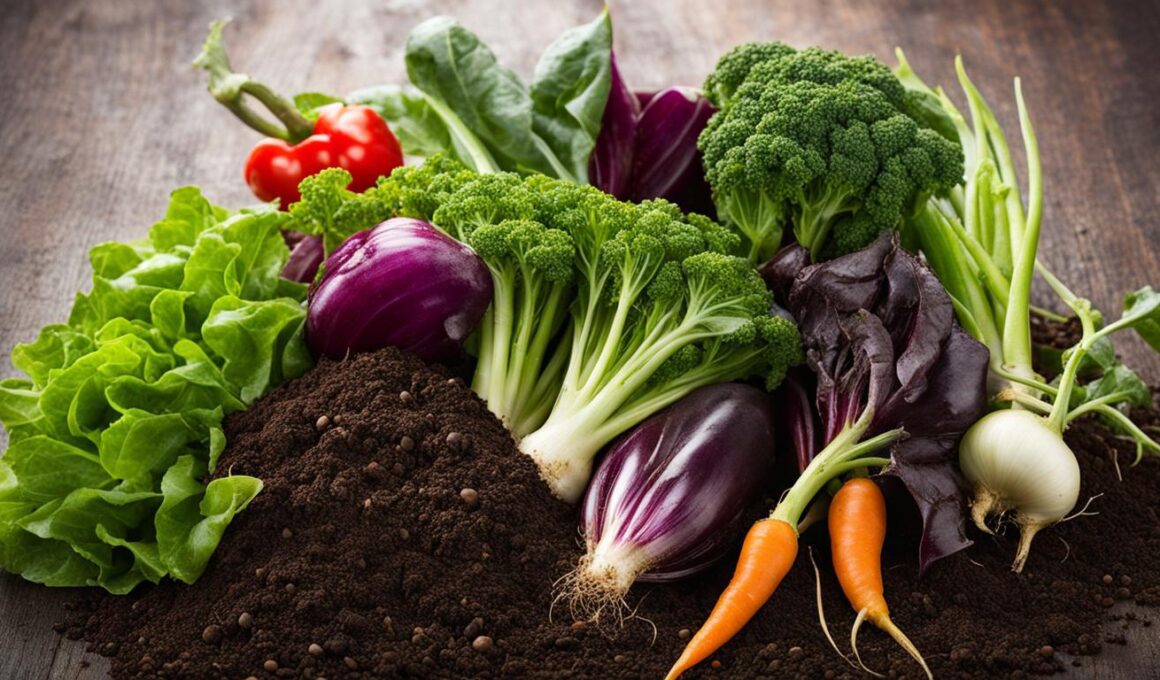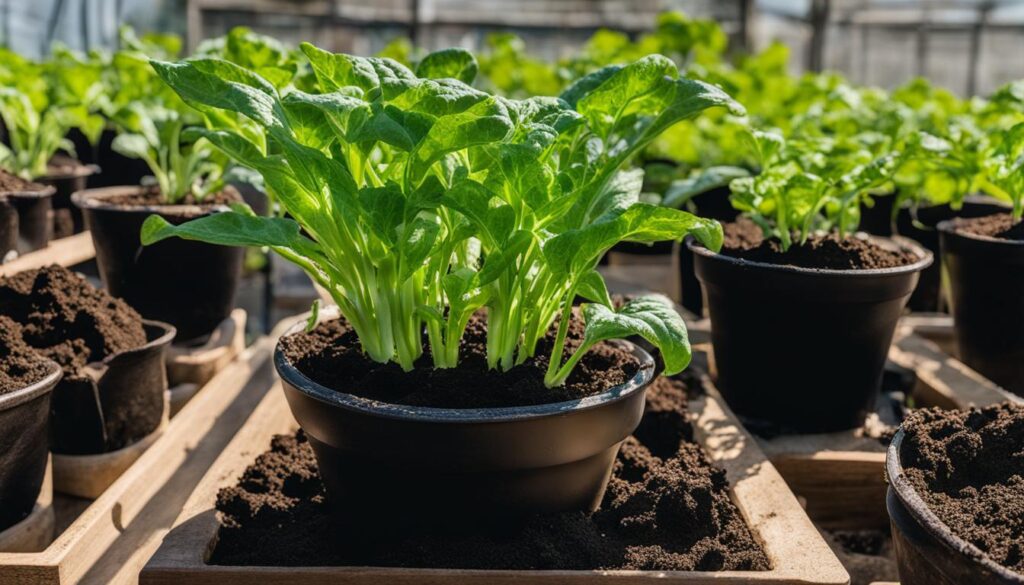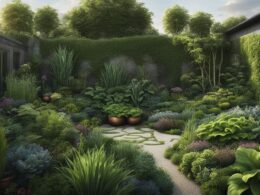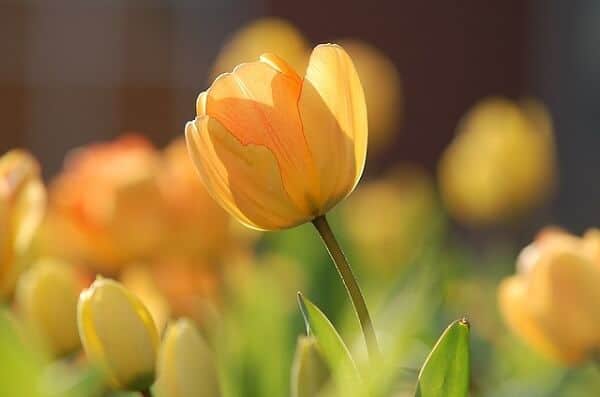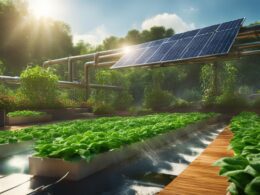Growing vegetables in containers is a great option for those with limited space. Container gardening allows you to create an ideal growing environment for vegetables while avoiding soil-borne diseases. When choosing a potting mix for vegetables, it is important to consider the size of the container and the specific needs of the plants. For smaller plants like lettuce and beans, a 10-inch pot is sufficient, while larger plants like tomatoes and eggplants require a larger 18-inch pot. It is crucial to ensure that the containers have drainage holes to prevent overwatering. Using a premium potting mix like Miracle-Gro® Potting Mix or Miracle-Gro® Moisture Control® Potting Mix provides the right blend of materials for optimal growth. Finally, placing your container vegetable garden in a sunny spot and providing regular watering and fertilization will help your vegetable plants thrive.
Key Takeaways:
- Growing vegetables in containers is an excellent option for limited space.
- Choose the right pot size based on the specific needs of your plants.
- Ensure containers have drainage holes to prevent overwatering.
- Using a premium potting mix like Miracle-Gro® or Espoma Organic can enhance plant growth.
- Place your container vegetable garden in a sunny spot and provide regular care for optimal results.
Choose the Right Size Pot for Your Vegetables
Growing vegetables in containers requires careful consideration of the pot sizes to ensure optimal growth and development of the plants. The size of the pot depends on the specific vegetable you are growing. Smaller plants like leaf lettuce and bush beans can thrive in a 10-inch pot, while larger plants such as tomatoes and eggplants require an 18-inch pot or larger.
When choosing the pot size, it’s important to provide enough space for the plant to grow and establish a strong root system. A spacious container will allow the roots to spread and access the necessary nutrients and water. It’s also important to consider the number of plants that can fit in a pot. For example, a 10-inch pot can accommodate one plant of leaf lettuce or Swiss chard, while a 14-inch pot can accommodate multiple plants like cabbage, peas, and spinach.
Proper drainage is essential for container gardening, so it’s crucial to choose containers with drainage holes to prevent waterlogged soil. These holes allow excess water to escape, preventing root rot and other moisture-related issues. By selecting the right pot size and ensuring proper drainage, you can provide your vegetables with the ideal growing environment they need to thrive.
| Vegetable | Recommended Pot Size |
|---|---|
| Leaf Lettuce | 10-inch pot |
| Bush Beans | 10-inch pot |
| Tomatoes | 18-inch pot or larger |
| Eggplants | 18-inch pot or larger |
| Cabbage | 14-inch pot |
| Peas | 14-inch pot |
| Spinach | 14-inch pot |
Table: Recommended pot sizes for different vegetables in container gardening.
The Importance of Using Premium Potting Soil
When it comes to container gardening, using premium potting soil is crucial for creating an optimal growing environment for your vegetables. Premium potting mixes, like Miracle-Gro® Potting Mix and Miracle-Gro® Moisture Control® Potting Mix, provide a well-balanced blend of materials that promote healthy root development and overall plant growth.
What sets premium potting soil apart from regular soil is its ability to provide proper drainage and aeration while retaining moisture. These mixes are less dense than garden soil, allowing excess water to drain away, preventing overwatering and root rot. At the same time, they contain ingredients such as moisture retention granules, coconut coir, and peat moss, which help retain moisture and prevent under-watering.
Additionally, premium potting soil is specifically formulated for vegetable gardening, ensuring that it contains the necessary nutrients for your plants to thrive. These mixes are rich in organic matter, which provides essential nutrients that your vegetables need to grow and produce bountiful harvests. By using premium potting soil, you can create a nutrient-rich environment that will support the healthy growth and development of your vegetable plants.
| Benefits of Using Premium Potting Soil | Benefits of Using Regular Soil |
|---|---|
| Proper drainage and aeration | Potential for waterlogging and poor aeration |
| Moisture retention | Varies depending on soil composition |
| Optimal nutrient content | May require additional fertilizer |
| Reduced risk of soil-borne diseases | Potential for soil-borne diseases |
Using premium potting soil sets the foundation for success in your container vegetable garden. It provides the necessary ingredients for optimal growth, including proper drainage, moisture retention, and nutrient content. By investing in premium potting soil, you are giving your vegetables the best chance to flourish and thrive.
Tips for Growing Vegetables in Containers
Growing vegetables in containers can be a rewarding and efficient way to cultivate fresh produce, even if you have limited space. To ensure successful growth, here are some valuable tips to consider:
Choose the Right Containers
When selecting containers for your vegetable garden, opt for pots that have drainage holes to prevent overwatering. The size of the container will depend on the specific vegetable you are growing. Smaller plants like lettuce and herbs can thrive in 10-inch pots, while larger plants like tomatoes and peppers require 18-inch pots or larger. Make sure the containers are sturdy enough to support the weight of the plants as they grow.
Provide Adequate Sunlight
Most vegetable plants require at least six hours of direct sunlight each day. Choose a sunny spot for your container garden, preferably in an area with southern exposure. If you have limited access to direct sunlight, consider using reflective surfaces or mirrors to redirect sunlight towards your plants. Rotate your containers regularly to ensure all sides of the plants receive equal sunlight.
Proper Watering and Fertilization
Container-grown vegetables can dry out quickly, so regular watering is essential. Check the soil moisture daily and water whenever the top inch becomes dry. Avoid overwatering, as it can lead to root rot and other plant diseases. Additionally, fertilize your vegetable plants regularly with a balanced fertilizer to provide the necessary nutrients. Look for fertilizers specifically formulated for vegetables, such as Miracle-Gro® Shake ‘N Feed for Tomatoes, Fruits & Vegetables.
| Container Gardening Tips | |
|---|---|
| Choose containers with drainage holes to prevent overwatering. | ✓ |
| Select the right container size for each vegetable. | ✓ |
| Place containers in a sunny spot with at least six hours of sunlight. | ✓ |
| Water regularly, checking soil moisture daily. | ✓ |
| Fertilize your plants with a balanced fertilizer for optimal growth. | ✓ |
Growing vegetables in containers can bring the joy of gardening to even the smallest spaces. By following these tips, you can create a thriving container garden and enjoy a bountiful harvest of fresh, homegrown vegetables throughout the season.
Factors to Consider When Choosing Potting Soil for Vegetables
When it comes to growing vegetables in containers, choosing the right potting soil is crucial for ensuring healthy plant growth and a bountiful harvest. There are several factors to consider when selecting potting soil for your vegetables:
- Drainage and Aeration: The potting soil should have good drainage and aeration properties to prevent waterlogging and provide oxygen to the roots. Look for mixes that contain perlite or vermiculite, which improve drainage.
- Nutrient Content: Opt for potting soils that contain organic materials like compost, bat guano, manure, seaweed, or worm castings. These ingredients provide essential nutrients for plant growth and help maintain soil fertility.
- Moisture Retention: Consider potting mixes that include moisture retention granules, coconut coir, or peat moss. These materials help the soil retain moisture, reducing the frequency of watering while ensuring that the plants have adequate hydration.
- Fertilizer: Check if the potting soil already includes fertilizer or if it needs to be added separately. Some potting mixes come with slow-release fertilizers that provide nutrients to the plants over time, while others may require additional fertilization.
- Organic vs. Synthetic: Decide whether you prefer organic or synthetic potting soil. Organic mixes are made from natural ingredients and are free from chemical additives, making them a popular choice for environmentally-conscious gardeners.
Remember to always read the product labels and choose a potting soil that aligns with your gardening practices and preferences. Investing in a high-quality potting mix will provide your vegetables with the optimal growing medium they need for vigorous growth, abundant yields, and healthy, tasty produce.
Choosing the right potting soil is crucial for ensuring healthy plant growth and a bountiful harvest.
Comparison of Potting Soil Brands for Vegetables
| Potting Soil Brand | Drainage and Aeration | Nutrient Content | Moisture Retention | Fertilizer | Organic vs. Synthetic |
|---|---|---|---|---|---|
| Miracle-Gro® Potting Mix | Good | Organic materials | Moisture retention granules, peat moss | Requires additional fertilizer | Synthetic |
| Miracle-Gro® Moisture Control® Potting Mix | Good | Organic materials | Moisture retention granules, coconut coir | Requires additional fertilizer | Synthetic |
| Espoma Organic Potting Mix | Good | Organic materials | Coconut coir | Requires additional fertilizer | Organic |
Table: Comparison of potting soil brands for growing vegetables in containers. The table showcases the drainage and aeration, nutrient content, moisture retention, fertilizer requirements, and whether the potting soil is organic or synthetic.
Choosing the right potting soil for your vegetable container garden is essential for providing your plants with the ideal growing conditions. By considering factors such as drainage, nutrient content, moisture retention, and fertilizer requirements, you can select a potting mix that meets the specific needs of your vegetables. Whether you opt for a synthetic blend like Miracle-Gro® Potting Mix or a natural option like Espoma Organic Potting Mix, investing in quality potting soil will help ensure successful vegetable gardening and a gratifying harvest.
Is Potting Mix Suitable for Growing Vegetables?
Yes, potting mix for vegetables is suitable for growing a variety of vegetables. This specialized mix provides the right balance of nutrients and drainage for vegetable plants to thrive. Whether you are growing tomatoes, peppers, or leafy greens, using potting mix designed for vegetables can lead to a successful harvest.
Conclusion
Growing vegetables in containers using the right potting mix is a convenient and effective way to enjoy fresh produce even with limited space. By choosing the right pot size, using premium potting soil, and providing proper care and maintenance, you can create an optimal growing environment for your vegetable plants.
Products like Miracle-Gro® Potting Mix, Miracle-Gro® Moisture Control® Potting Mix, and Espoma Organic Potting Mix are highly recommended for their nutrient-rich formulas and ability to support healthy plant growth. These premium potting soils contain a blend of materials that provide proper drainage, aeration, and moisture retention, ensuring your vegetable plants get the necessary nutrients and support for optimal growth.
Whether you are a beginner or an experienced gardener, selecting the best potting soil for your vegetables will ensure a successful and abundant harvest. Consider factors such as drainage, organic content, and fertilizer needs when choosing a potting mix that aligns with your gardening practices and preferences.
With the right potting mix and proper care, you can have a thriving container vegetable garden and enjoy the satisfaction of growing your own fresh and delicious vegetables. So get started and happy gardening!
FAQ
Can I use potting mix for growing vegetables?
Yes, potting mix is suitable for growing vegetables in containers. It creates an ideal growing environment and helps prevent soil-borne diseases.
What size pot should I use for growing vegetables?
The size of the pot depends on the specific vegetable. Smaller plants like lettuce and beans can be grown in a 10-inch pot, while larger plants like tomatoes and eggplants require an 18-inch pot or larger.
Why is using premium potting soil important for vegetable gardening?
Premium potting soil like Miracle-Gro® Potting Mix or Miracle-Gro® Moisture Control® Potting Mix provides the right blend of materials for optimal growth. It ensures proper drainage, air flow, and moisture retention, providing the necessary nutrients for healthy plant growth.
What are some tips for growing vegetables in containers?
Choose a sunny spot for your container garden, water regularly, and provide regular fertilization. Consider using micro-climates and installing a drip irrigation system to automate watering.
What factors should I consider when choosing potting soil for vegetables?
Consider the drainage and aeration of the soil, organic materials for nutrients, ingredients that improve drainage or retain moisture, and whether the soil already includes fertilizer or not.
What is the best potting soil for vegetables?
Premium potting mixes like Miracle-Gro® Potting Mix, Miracle-Gro® Moisture Control® Potting Mix, and Espoma Organic Potting Mix are highly recommended for their nutrient-rich formulas and ability to support healthy plant growth.





